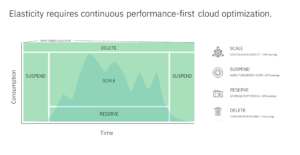
In 2024, the initial cultural fascination with early generative AI yields tangible business results. This technology, which includes the ability to process and generate text, voice and video content, is revolutionizing how companies enhance productivity, foster innovation and stimulate creativity. According to McKinsey & Company, these AI applications have the potential to contribute between USD 2.6 trillion and 4.4 trillion annually to the global economy through various business scenarios.
Using insights from extensive collaborations with customers and partners in more than 25 countries, we’re excited to share well-informed predictions and emerging trends for 2024. This global perspective enabled us to observe how diverse industries both influence and are influenced by the evolving technology landscape. Here’s a glimpse into what the future holds.
1. Customization of enterprise AI
Enterprise AI customization is on the rise, with businesses embracing tailored generative AI applications. These applications are designed to meet specific business needs by integrating proprietary data and help to ensure more accurate and relevant responses. This trend signals a move toward more efficient and personalized AI-driven business solutions. For example, a global retail chain might adopt region-specific AI models that are trained on data, such as customer preferences and cultural nuances. This approach results in highly personalized customer interactions.
In Japan, AI prioritizes efficiency and precision, while in Brazil, it emphasizes warmth and engagement, reflecting each market’s cultural values. This trend is expected to extend to various industries, transforming AI from a generic tool into a vital strategic asset. Businesses increasingly rely on AI for customer engagement, operational efficiency and market competitiveness, leading to a dynamic business landscape where AI fuels innovation and addresses specific market and operational challenges.
2. Open source AI models
In 2024, open source pretrained AI models gain significant traction, empowering businesses to accelerate growth by combining these models with private or real-time data. This synergy enhances productivity and cost-efficiency. IBM actively contributes to open source AI models, which are exemplified by its collaboration with NASA.
A noteworthy contribution is the geospatial AI foundation model, the largest of its kind on the Hugging Face platform and a pioneering open source AI foundation model created in partnership with NASA. This model expands access to NASA’s earth science data, particularly for geospatial intelligence and advancing climate-related research. Derived from NASA’s satellite data, this model demonstrates the commitment by IBM to use open source technologies for critical areas such as climate change.
By making this model available on Hugging Face, a well-known repository for transformer models, IBM and NASA aim to democratize access and encourage its application in climate and earth science innovations. The model has shown impressive results, achieving a 15% improvement over state-of-the-art techniques with only half the labeled data, making it a potent tool for tasks like deforestation tracking, crop yield prediction and greenhouse gas detection and monitoring.
3. API-driven AI and microservices
The proliferation of application programming interfaces (APIs) will simplify the creation of complex AI-driven applications, boosting productivity across various sectors. IBM developed a suite of custom AI microservices for a retailer, accessible through APIs. These services included customer behavior analysis, inventory management and personalized marketing tools.
A key feature was the integration of IBM’s AI-powered intelligent assistants into the retailer’s customer service system. These assistants, capable of handling numerous customer inquiries in real time, provided tailored responses based on individual customer data. Additionally, the retailer used IBM’s AI-driven summarization tools to efficiently analyze customer feedback and sales data, enabling swift and informed decision-making. The impact was significant: customer service efficiency improved, marketing strategies became more data-driven and inventory management was optimized. The flexibility and scalability of these API-driven solutions enabled the retailer to adapt rapidly to market changes.
4. AI as a national priority
Recognizing AI’s immense potential, nations worldwide are expected to prioritize its development in a manner reminiscent of a new space race. This heightened focus drives significant advances in research, science and economic growth, firmly establishing AI as a strategic global asset.
In 2023, the European Union demonstrated its commitment to elevating AI as a national priority by progressing toward the finalization of the European Union Artificial Intelligence Act (EU AI Act). This historic legislation represents the world’s inaugural comprehensive legal framework for artificial intelligence, categorizing AI systems into different risk levels (unacceptable risk, high risk and limited risk) and imposing corresponding obligations.
The EU AI Act legislation represents a significant step in the regulation of AI deployment within the EU, encompassing a wide array of AI applications, ranging from high-risk scenarios like AI usage in sensitive systems such as welfare, employment, education and transport, to low-risk applications like chatbots. Also, the EU AI Act prohibits certain AI applications that are considered to pose unacceptable risks, including the use of emotion recognition in the workplace and social scoring based on social behavior or personal characteristics.
5. Multimodal generative AI
Transitioning from text-based generative AI to multimodal language, the integration of text, speech and images promises contextually relevant responses and fosters innovation across diverse sectors. For instance, during a customer service call, AI can analyze a client’s spoken request, interpret their financial documents and assess their facial expressions in a video consultation. By synthesizing these data points (speech, text and visual cues), AI can provide more personalized financial advice and enhance creditworthiness assessments with precision.
6. AI safety and ethics
As AI becomes more integrated into our lives, the focus on AI safety and ethics intensifies. Leading AI organizations are collaborating to develop robust AI systems with standardized safety protocols and best practices to help ensure ethical AI usage. IBM and Meta started the AI Safety Alliance to address AI concerns, along with industry leaders like Intel, Oracle, AMD, Dell and the Linux® Foundation. This alliance aims to create alternatives to closed AI systems, foster responsible AI innovation and help ensure scientific rigor, trust, safety, security, diversity and economic competitiveness. It also supports AI hardware growth, advances open AI technology development, and establishes global benchmarks, resources and standards for responsible AI development. This initiative reflects IBM’s commitment to AI safety and ethics, promoting open innovation in AI development.
Embracing the future: A call to action for the AI-driven world of 2024
These trends and predictions aren’t mere technological forecasts. They serve as a roadmap for innovation, growth and societal advancement. As AI evolves, it challenges us to rethink not only our business practices but also our interactions with the world. The potential of AI is vast and its impact is just beginning. By staying informed, adaptable and proactive, we can harness the power of AI to build a more efficient, innovative and inclusive future.
Learn more about the AI allianceIBM Newsletters
Get our newsletters and topic updates that deliver the latest thought leadership and insights on emerging trends.Subscribe now More newsletters
- SEO Powered Content & PR Distribution. Get Amplified Today.
- PlatoData.Network Vertical Generative Ai. Empower Yourself. Access Here.
- PlatoAiStream. Web3 Intelligence. Knowledge Amplified. Access Here.
- PlatoESG. Carbon, CleanTech, Energy, Environment, Solar, Waste Management. Access Here.
- PlatoHealth. Biotech and Clinical Trials Intelligence. Access Here.
- Source: https://www.ibm.com/blog/top-6-predictions-for-ai-advancements-and-trends-in-2024/
- :has
- :is
- :not
- :where
- $UP
- 1
- 12
- 20
- 2020
- 2023
- 2024
- 25
- 28
- 30
- 300
- 31
- 400
- 41
- 43
- 72
- 9
- a
- ability
- About
- Academia
- accelerate
- access
- accessible
- According
- accurate
- achieving
- across
- Act
- Action
- actively
- adapt
- Additionally
- address
- addresses
- adopt
- Adult
- advancement
- advancements
- advances
- advancing
- Advertising
- advice
- AI
- AI Act
- AI models
- AI strategy
- AI systems
- AI-powered
- aim
- aims
- All
- Alliance
- along
- also
- alternatives
- AMD
- Americans
- amp
- an
- analysis
- analytics
- analyze
- and
- Annually
- APIs
- Application
- applications
- approach
- ARE
- areas
- Array
- article
- artificial
- artificial intelligence
- AS
- assess
- assessments
- asset
- assistants
- At
- author
- Automation
- available
- back
- Bangkok
- based
- became
- become
- becomes
- becoming
- been
- Beginning
- behavior
- benchmarks
- benefits
- BEST
- best practices
- between
- Black
- Blog
- Blue
- boosting
- both
- Brazil
- build
- burden
- business
- business development
- business practices
- businesses
- businessman
- but
- button
- by
- call
- call to action
- CAN
- capable
- Capacity
- carbon
- card
- cardiovascular
- Cardiovascular Disease
- Cards
- care
- CAT
- categorizing
- Category
- certain
- chain
- challenges
- change
- Changes
- characteristics
- chatbots
- check
- circles
- class
- Climate
- Climate change
- closed
- Cloud
- cloud infrastructure
- collaborating
- collaboration
- collaborations
- colleagues
- color
- combining
- commitment
- Companies
- competitiveness
- complex
- components
- comprehensive
- Concerns
- considered
- consultation
- Container
- content
- continue
- contribute
- contributes
- contribution
- Corresponding
- countries
- COVID-19
- COVID-19 pandemic
- create
- created
- Creating
- creation
- creativity
- creditworthiness
- critical
- crop
- CSS
- cultural
- custom
- customer
- customer behavior
- customer data
- Customer Engagement
- Customer Service
- Customers
- customization
- cyberattacks
- data
- data points
- data storage
- data-driven
- Date
- December
- Decision Making
- decisions
- Default
- definitions
- deforestation
- deliver
- delivering
- Dell
- democratize
- demonstrated
- demonstrates
- deployment
- Derived
- description
- designed
- Detection
- develop
- developed
- Development
- Diabetes
- died
- different
- difficult
- digital
- Disease
- diseases
- disproportionate
- disruptions
- diverse
- Diversity
- documents
- Domestic
- driven
- drives
- due
- during
- dynamic
- each
- Early
- earth
- Economic
- Economic growth
- economy
- Education
- efficiency
- efficient
- efficiently
- elevating
- embracing
- emerging
- emotion
- emphasizes
- employment
- empowering
- enabled
- enabling
- encompassing
- encourage
- engagement
- enhance
- Enhances
- ensure
- Enter
- Enterprise
- environments
- establishes
- establishing
- Ether (ETH)
- ethical
- ethics
- EU
- European
- european union
- Even
- EVER
- Every
- evolves
- evolving
- example
- excited
- Exit
- expands
- expected
- expressions
- extend
- extensive
- extreme
- fabric
- Face
- facial
- false
- far-reaching
- Feature
- feedback
- financial
- financial advice
- firmly
- Flexibility
- Focus
- follow
- fonts
- For
- Force
- forecasts
- Foster
- fosters
- Foundation
- Framework
- from
- fuels
- full
- further
- future
- Gain
- GAS
- generate
- generative
- Generative AI
- generator
- geopolitical
- get
- Giving
- Glimpse
- Global
- Global economy
- greenhouse gas
- Grid
- Growing
- Growth
- Half
- Handling
- Hardware
- harness
- Have
- head
- Heading
- Health
- healthcare
- height
- heightened
- help
- helps
- High
- high-risk
- higher
- highly
- his
- historic
- holds
- Hospital
- hospitality
- How
- How To
- However
- HTTPS
- human
- human intelligence
- Hybrid
- hybrid cloud
- IBM
- ICO
- ICON
- image
- images
- immense
- Impact
- impacting
- implications
- important
- imposing
- impressive
- improved
- improvement
- in
- Inaugural
- included
- includes
- Including
- Inclusive
- increasingly
- index
- individual
- industries
- industry
- influence
- influenced
- informed
- Infrastructure
- initial
- Initiative
- Innovation
- innovations
- innovative
- Inquiries
- insights
- instance
- Institute
- integrated
- Integrating
- integration
- Intel
- Intelligence
- Intelligent
- Intensifies
- interactions
- interfaces
- into
- inventory
- Inventory Management
- issues
- IT
- ITS
- January
- Japan
- jpg
- just
- Key
- Kind
- labor
- landscape
- language
- large
- largest
- latest
- lead
- leader
- leaders
- Leadership
- leading
- LEARN
- Legal
- legal framework
- Legislation
- levels
- Life
- Life Sciences
- like
- Limited
- limited access
- Lives
- local
- locale
- low-risk
- Machines
- make
- Making
- manage
- management
- manner
- manufacturing
- Market
- Marketing
- Marketing Strategies
- Markets
- max-width
- McKinsey
- Meet
- mere
- Meta
- microservices
- Mid
- might
- min
- minutes
- missing
- Mobile
- model
- models
- monitoring
- more
- more efficient
- mother
- move
- Nasa
- National
- Nations
- Navigation
- nearly
- Need
- needs
- New
- Newsletters
- NIH
- noteworthy
- nothing
- now
- nuances
- numerous
- obligations
- observe
- of
- off
- offer
- Office
- on
- ONE
- only
- open
- open innovation
- open source
- operational
- Operations
- opportunities
- Opportunity
- optimized
- or
- oracle
- organizations
- our
- out
- over
- page
- pandemic
- particularly
- partners
- Partnership
- percentage
- personal
- Personalized
- perspective
- PHP
- Pioneering
- platform
- plato
- Plato Data Intelligence
- PlatoData
- plugin
- points
- policy
- population
- position
- positive
- Post
- potent
- potential
- power
- practices
- Precision
- prediction
- Predictions
- preferences
- presentation
- presents
- primary
- Prioritize
- prioritizes
- priority
- private
- Proactive
- process
- productivity
- Programming
- progressing
- promises
- promoting
- proprietary
- protocols
- provide
- provided
- public
- published
- Race
- ranging
- rapidly
- Rates
- Reading
- real
- real-time
- real-time data
- reason
- recent
- recognition
- reflecting
- reflects
- Regulation
- reinvent
- relevant
- rely
- reminiscent
- report
- repository
- represents
- request
- research
- resilience
- Resources
- responses
- responsible
- responsive
- Results
- retail
- retailer
- Revealed
- Revolutionizing
- Ring
- Rise
- Risk
- risks
- road
- roadmap
- robots
- robust
- Role
- s
- Safety
- sales
- satellite
- Scalability
- scenarios
- Science
- SCIENCES
- scientific
- scoring
- Screen
- scripts
- Sectors
- security
- sensitive
- seo
- serve
- service
- Services
- several
- Share
- showing
- shown
- signals
- significant
- siloed
- Simple
- simplify
- site
- small
- smaller
- Social
- societal
- Solutions
- Source
- Space
- space race
- specific
- speech
- spoken
- Sponsored
- spread
- squares
- standardized
- standards
- start
- started
- state-of-the-art
- stated
- stating
- staying
- Step
- stimulate
- storage
- store
- Strategic
- strategies
- Strategy
- subscribe
- successful
- such
- suite
- supply
- supply chain
- Supports
- SVG
- SWIFT
- synergies
- synergy
- system
- Systems
- Tablet
- tackle
- tailored
- Take
- talking
- tangible
- tasks
- Technical
- technological
- Technologies
- Technology
- Technology Development
- tensions
- tertiary
- text
- than
- that
- The
- The Future
- the world
- their
- theme
- These
- they
- this
- though?
- thought
- thought leadership
- threat
- Through
- time
- Title
- to
- today
- tool
- tools
- top
- topic
- toward
- Tracking
- traction
- traditionally
- trained
- transformational
- transformative
- transformer
- transforming
- transport
- Trend
- Trends
- Trillion
- Trust
- type
- union
- Updates
- URL
- us
- Usage
- USD
- use
- used
- using
- Values
- various
- Vast
- Video
- visibility
- visual
- vital
- Voice
- W
- warmth
- was
- Way..
- we
- Welfare
- well-known
- were
- What
- which
- while
- white
- wide
- will
- willing
- with
- within
- without
- WordPress
- Workforce
- Workplace
- world
- world’s
- worldwide
- written
- years
- Yield
- yields
- you
- Your
- zephyrnet

















